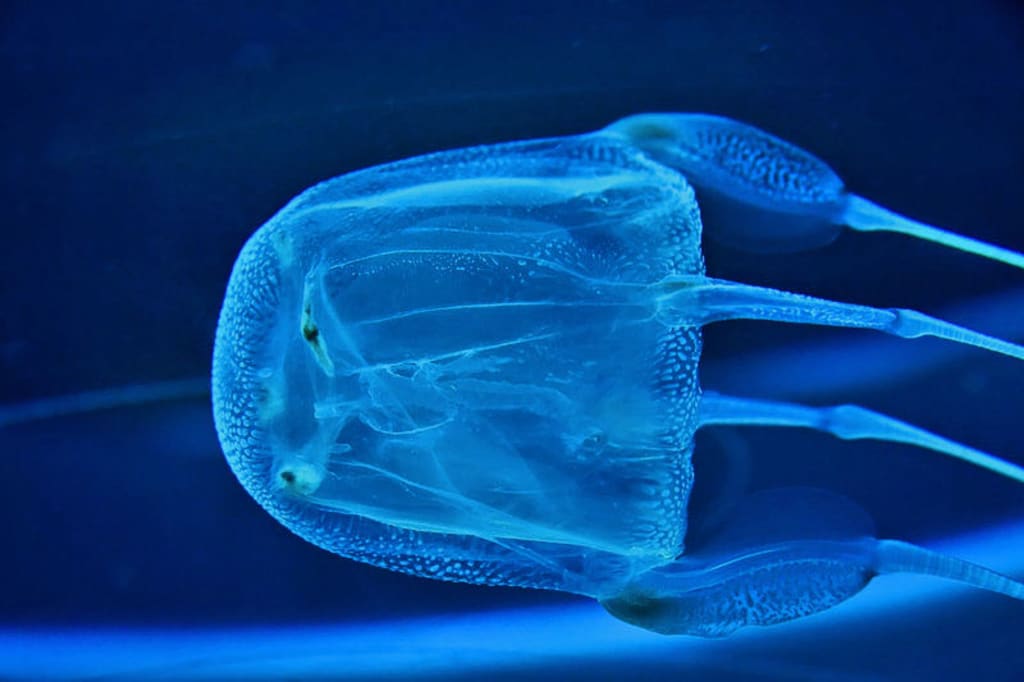The Box Jellyfish
Basically the Devil

Box Jellyfish are very old, surviving for more than 500 million years. One woman named Diana Nyad, known for swimming from Cuba to Florida, was not as successful as she appears. Three of her five attempts were stopped by the horrid sting of the Box Jellyfish. Although she was hospitalized for several weeks, that determined woman fought through the blood-curdling experience of a sting. If you haven’t heard before, the Box Jellyfish are very powerful creatures, leaving you wanting to die.
Box Jellyfish Habitat
To start with, a Box Jellyfish’s habitat is changing drastically. They have migrated all over the world, leaving many places with danger. The Box Jellyfish originated from Australia, leaving it deadlier than it should be. Although many people believe that global warming is a hoax, the warm waters are causing the creatures to venture to other oceans. First, these jellyfish are making their way to Florida, Thailand, Japan, and some United Kingdom waters. Another reason is because the Box Jellyfish have a lack of food in Australia, and have a large population of food in other seas. Lastly, the jellyfish are becoming threatened by the humans of Australia, causing them to leave their home. These beasts are slowly drifting out of their habitat and into an ocean filled with now threatened creatures.
Box Jellyfish Predator and Prey
Next, these jellyfish may seem nearly harmless floating around, but when lunchtime comes around their appetites are enormous, though they need to watch out for danger. First of all, the Box Jellyfish eat sea worms such as the Arrow worms and Annelid worms. They also eat crustaceans like shrimp and a type of prawn from the family of Sergestidae. Last, while many jellyfish are small, they still can eat small fish and plankton. Even though it implies that they are king around 12 o’clock, they need to watch out for their own danger. They get gulped down by sea turtles, other jellyfish, and killed by us humans. Box Jellyfish may seem tiny and helpless, but they are devils within seconds.
Box Jellyfish Characteristics
Third of all, Box Jellyfish are unique and unlike any other jellies. First, these jellyfish are umbrella shaped and have 24 eyes. Box Jellyfish are the only jellyfish that have eyes, some of the many eyes are dark, and others light. Also, Box Jellyfish can swim on their own, swimming up to an amazing 4 knots. They are able to move on their own without taking a lot of energy away and not leaving them exhausted. Lastly, Box Jellyfish can shrink if they don’t eat, the warm water is extending their stinging season, and they sleep at night, unlike most sea creatures. The Box Jellyfish has its own uncommon characteristics making this creature deadly, yet unbelievable.
Box Jellyfish Weight and Size
Another unique thing about Box Jellyfish is their size and weight. First, a full grown Box Jellyfish can be up to 10 feet long (including tentacles), and 8 inches for each box side (not including tentacles). Second of all, these Jellyfish might lack in size, but still are as savage as others. Just like the length, these jellyfish can be as wide as 10 inches, yet can be less than a centimeter. Box Jellyfish may have no heart, bones, and lungs, but they still can have a nice amount of weight being carried upon them. Last, Box Jellyfish can weigh less than an ounce, yet many can get up to 4.4 pounds. These jellyfish may be made out of pure jelly and a few eyes, but they can easily be weighed down by their own weight.
Box Jellyfish Stings
Now, what are the Box Jellyfish known for? Not the eyes, not migrations, not their prey, but their sting. Box Jellyfish stings are fatal without the correct treatment when stung, but they still do harm. The common symptoms are burning and prickling pain, brown, red, or purple marks on skin, itching, swelling, tingling, numbness, and throbbing pain. Still, those are the minor symptoms. The severe and dangerous symptoms are vomiting, headache, muscle and joint problems, dizziness, weakness, fever, difficulty breathing, and heart problems. Getting stung by a Box Jellyfish and having these symptoms is called the Irukandji Syndrome. Box Jellyfish are common for the well-known sting, causing outrageous pain on the body, throughout the region that he/she was stung.
Conclusion
Box Jellyfish have developed over the many years that they have been alive. Diana Nyad had been stung by a deadly Box Jellyfish, yet as determined as she was, tried multiple more times to accomplish her dream. That woman was kept in the hospital for many weeks having the horrifying symptoms of a sting. These jellyfish may look harmless and cute, but they are a meat-eating monster inside.
Sources
http://animals.nationalgeographic.com
http://animals.mom.me
http://travelnq.com/
http://www.bioexpedition.com
http://www.mayoclinic.org/
About the Creator
Grace Mitchell
Would love if I got gifts, but I’m not extremely desperate.... just need to save up money for life.
Love all of you guys!







Comments
There are no comments for this story
Be the first to respond and start the conversation.